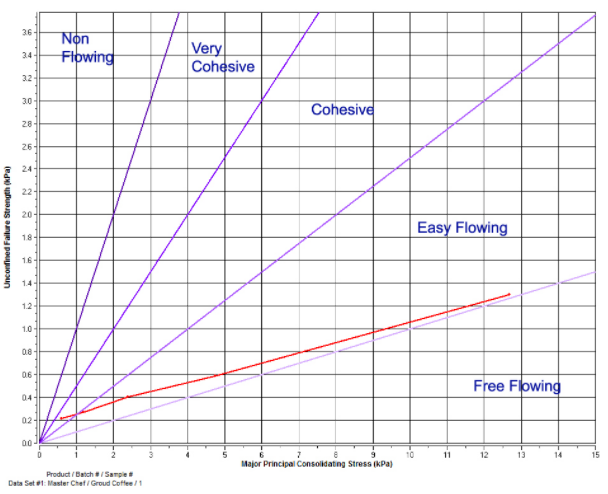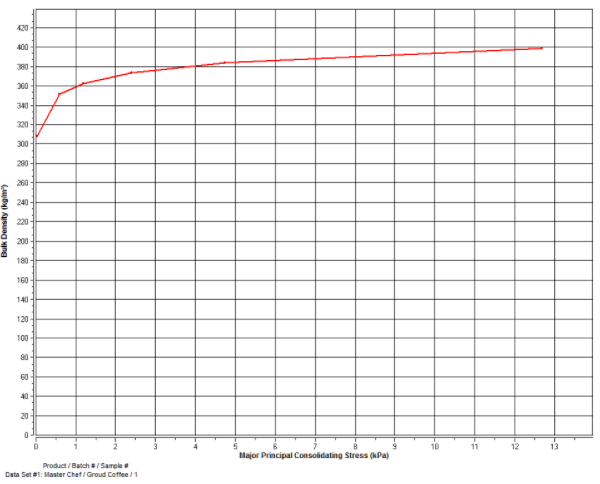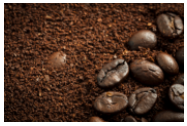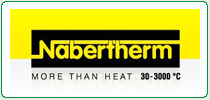USE
Determination of powder flow characteristics of ground coffee.
TEST EQUIPMENT
Instrument: Powder Flow Tester (PFT)
Trough: 230 cc, 6-inch diameter
Lid Type: Vane Lid, 304 s/s, 33cc, 6-inch diameter
Type of Test: Flow Function Test
Temperature: Room Temperature (70-72° F)
Humidity: 48%
TEST METHOD
A Brookfield Powder Flow Tester equipped with Powder Flow Pro software for automated instrument control and data acquisition, was used to test ground coffee. The coffee was scooped into the trough and the scraping tool was then used to evenly distribute the powder and form the sample. After recording the sample weight and entering it into the software, a standard flow function test was run. Time required for the test was 25 minutes.
PARAMETERS MEASURED
Flowability: Easy Flowing
Bulk Density: 308 kg/m³ (fill density) to 399 kg/m³ (final bulk density)
ANALYSIS
Hopper Shape: Conical
Arching Flow Factor: 0.119 m (119 mm; 4.6 in)
Rathole Diameter: 0.567 m (Bin diameter - 2 m)
RESULTS
Figure 1 shows the flowability of the ground coffee at different levels of consolidating stress. These results show that the coffee is generally easy flowing all levels of consolidating stresses. However, the material does gain strength as the feeder system is emptying becoming cohesive at the lowest consolidating stress.
Note: The Flow Function data is indicated by the red line. The other lines are references (or “Standard Flow Indices”), which distinguish the different types of flow behavior, ranging from “non-flowing” to “free flowing”.
The axes are Unconfined Failure Strength (kPa) vs. Major Principle Consolidating Stress (kPa)..

Figure 1: Ground Coffee Flow Function Graph
Figure 2 represents the arching dimension and rat-hole diameter (based on a standard bin diameter of 2 meters and a bin height of 8 meters). Ground coffee, based on the arching dimension, requires and opening of at least 0.119 m. To ensure a rat-hole does not form, an opening of 0.567 m is required. The rat-hole diameter is normally used as a gage of flowability.
|
Data Set (#) |
Arching Dimensions (m) |
Rat-hole Diameter (m) |
|
1 |
0.119 |
0.567 |
Figure 2: Arching Dimensions and Rate-hole Diameter
Figure 3 Figure 3 shows the bulk density of the material at different levels of consolidating stress. This graph tells us that the ground coffee has a fill density of about 308 kg/m³ and rises to about 399 kg/m³ at 12.685 kPa of consolidating stress. In general, a free flowing powder will show very small changes in bulk density, while a cohesive or poor flowing powder will generally show a large increase in bulk density. This ground coffee shows a
smaller increase in bulk density which indicates this powder is easy flowing.
The axes are Bulk Density (kg/m3) vs. Major Principle Consolidating Stress (kPa).

Figure 3: Ground Coffee Bulk Density Graph
CONCLUSION
The ground coffee is an easy flowing powder until the very lowest consolidation stress at which point it becomes cohesive. The ground coffee becomes increasingly cohesive as the feeder system is emptying, so it may experience flowability issues. However, these should be minor as the material is mostly easy flowing. The arching dimension and rat-hole diameter values indicate a material that will be easy to flow overall.
>>Download a pdf of this application note.
Contact us : This email address is being protected from spambots. You need JavaScript enabled to view it.

















